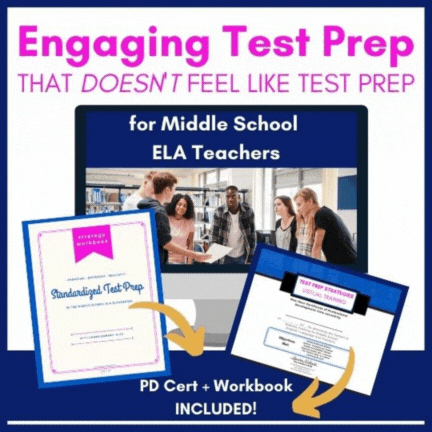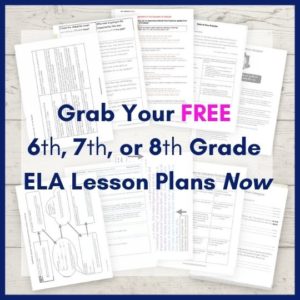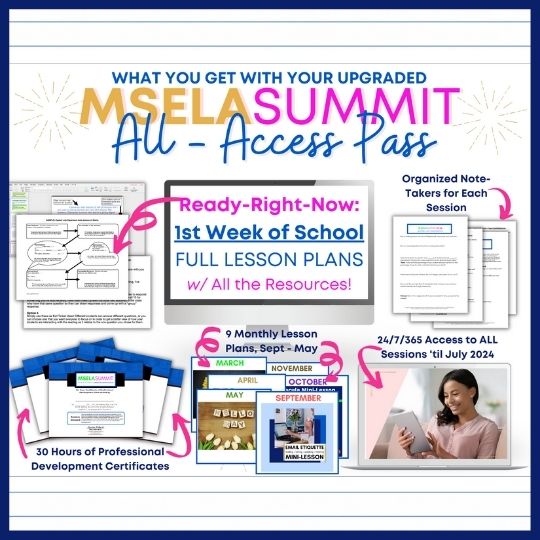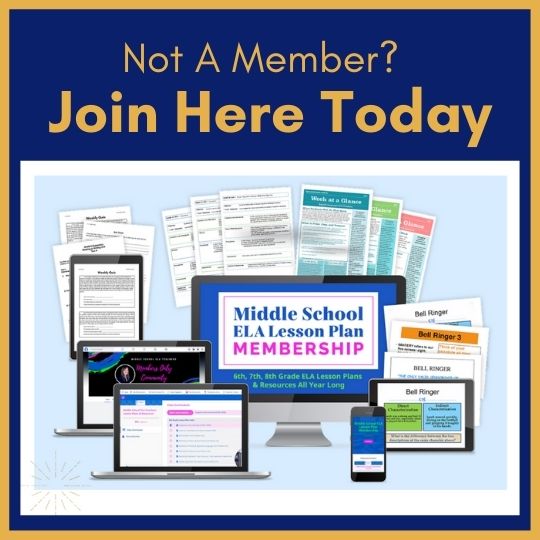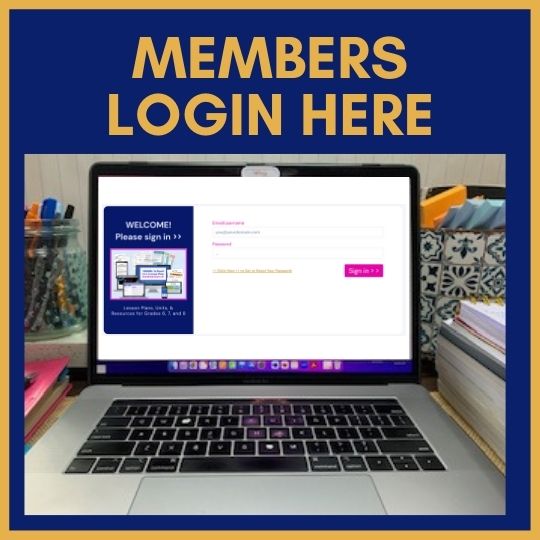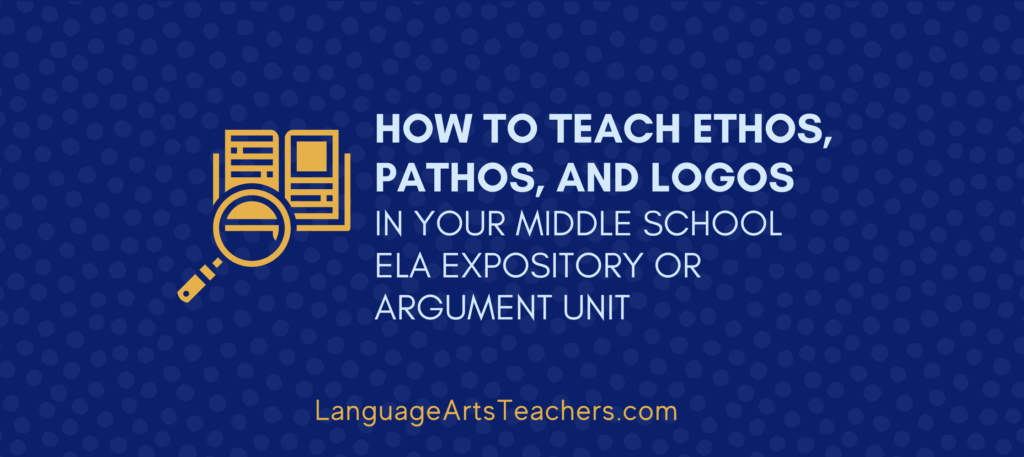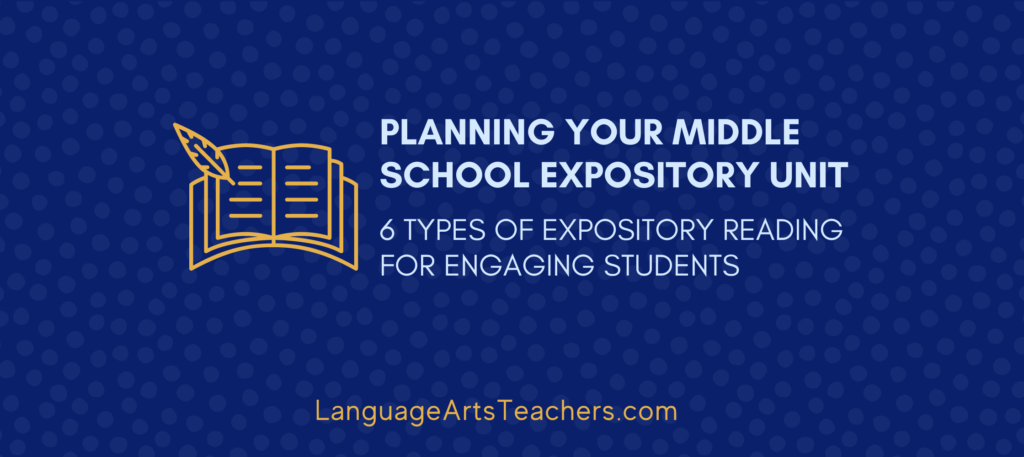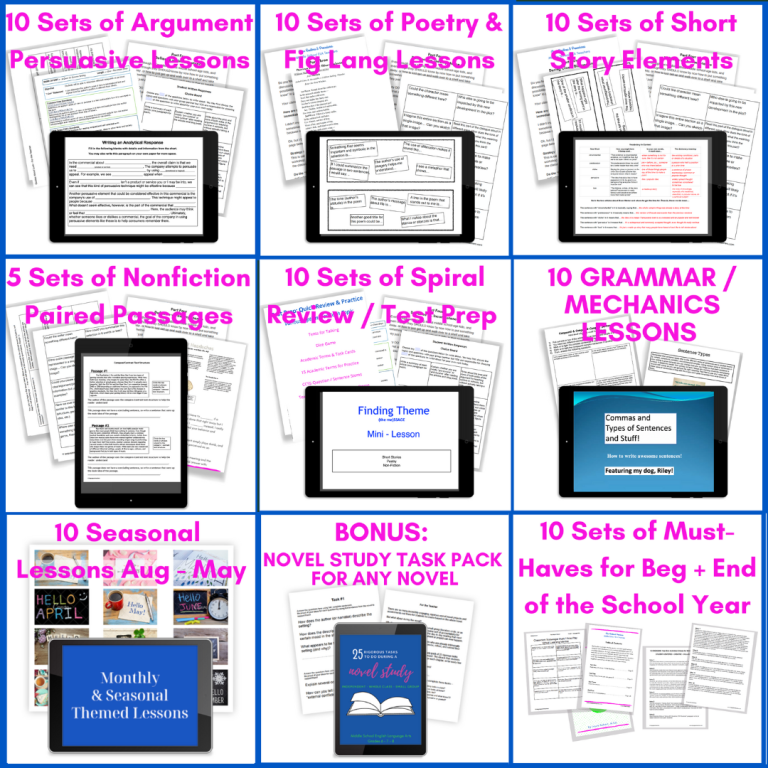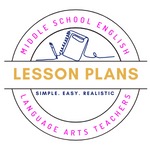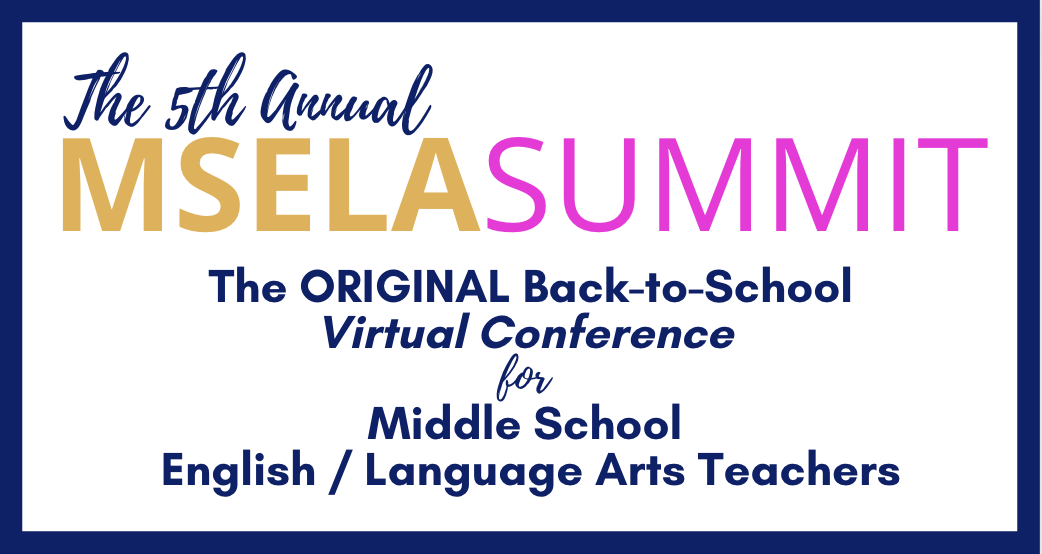Ok, I get these Q’s frequently from teachers who reach out to me regarding setting up and running stations or centers (same thing, basically) in their middle school English / Language Arts / Reading / Writing classes:
How do I make stations work so I can . . .
>> teach my students while also holding them accountable
>> leave at a good time each day without constantly grading or prepping materials
>> actually enjoy life AND teaching without stations taking over every waking moment
I get it! Me, too, my friend!
I’ve got four (4) realistic, actionable tips to share with you about stations specifically at the middle school level (like that 5th – 9th grade age group) that will leave you feeling
- Totally in control of your time and energy
- Excited and confident about running stations in your class
- Creative and organized to get this up and running, like tomorrow
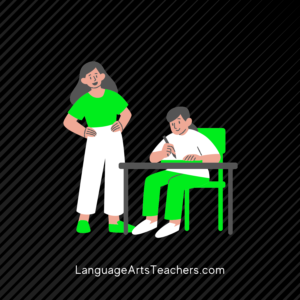
Tip #1
Getting Started with Stations
- Divide your students into groups of no more than five (don’t worry about how to group them, or what ‘level’ they’re at—you’ll do that another time)
- Give each group of students the same activity (yes, the same!)
- Set a timer so you and the students know how long they’ll be working
- Teach students your expectations for station work while they’re in the actual stations (voice level, noise volume, what to do if they have a question, etc.)
Once students understand your expectations, you can eventually start grouping them more strategically and start differentiating the work.
The goal of having all your groups work on the same thing is that you’re really teaching the classroom expectations for student work and behavior. It’s not about the actual assignment per se when you’re first starting out.
This is about figuring out what issues need to be addressed and tweaking your own procedures for station time.
You may need to repeat this whole “getting started with stations” part a few times until you feel confident that your students can work the way they need to work.
I’ve got three (3) more actionable tips coming your way in a sec, but first:
- Are you freaking out about how to run stations with only a 45 minute class period?
- Or a 90 minute class period?
- What about how much time to spend on each station activity, and how to move students or materials when it’s time to switch stations?
I go deep into those specifics in my image-rich and example-heavy Centers & Stations Training which you can get in on by clicking the button below (it’s free!):
Tip #2
Student Accountability & Avoiding Chaos During Station Time
First of all, some students will tend to use literally aaaaaany excuse to get out of completing (or starting) their work. The #1 excuse for not starting, completing, or putting in the quality work is this: I didn’t know what to do or how to do it I got stuck I don’t get it.
So the foundational tip when it comes to maximizing student accountability is to make sure that whatever the station activity is, it’s something students have done before (preferably something they’ve done multiple times successfully before).
This way, both you and they are super clear on what the outcome should look like within the amount of time they have to do it.
* We’ll go over types and examples of what station work can actually be in Tip #3 coming right up!
Another extremely helpful, life-altering tip for student accountability (is that too dramatic?) is to include the same basic procedural instructions for every station, and make sure it’s the same every time you put students into stations.
Quick Q: How often should you run stations in your class? Is this an everyday thing, or once a week, or just for certain projects or units?
Quick A: I go into ALL of ^that in my FREE Centers & Stations Training which you can register for by clicking right here (It’s absolutely worth every second of your time, and I’ll even give you a PD certificate that counts as one hour that you can add to your continuing education portfolio).
Here’s the type of information I include for every. single. station every time we jump into stations, all throughout the year:
- A bullet point instruction list for what students are actually, literally doing in the station
(Ex: – Take out the article we read last week called “……”
– Annotate ________ and ________ throughout the article
– Answer any two of the questions that appear on the sheet (you may
work together and discuss them, but have your own response sheet)
- A reason for the station work (Ex: “You’ll use this for your research project coming up” or “This is for the essay you’re writing on Friday.”)
- A list of what students should do before they claim that they’re done (Ex: Re-read the instructions, check each other’s spelling, have another student read your written response back to you to see if it makes sense).
- What to do with the work when they really are done (or when time is up). . . Does it go into a file drawer? Does it go into their own binder? Does it get submitted electronically to you?
- A pre-approved list of ideas that students can work on if they finish their station work and there’s still time left before switching stations, or before the end of class (read your independent choice novel, work through any of the class-approved websites for vocabulary or grammar practice, etc.)
I have a template with all ^those categories on it that I call my “Student Instruction Cards” and it’s so SO easy for me to leave everything in it the same for almost any station we do throughout the year, except for the very first item (the specific instructions for that station’s activity).
Get the Student Instruction Card template + organized station materials in my free, image-rich and example-heavy Centers & Stations Training which you can access by clicking the button below:

Tip #3
Realistic Station Ideas
What can stations actually be?
Like, what do the activities or lessons consist of?
Where do I get all the station work resources that I need?
>> This is my favorite part to share with teachers because once I figured out the answers to all ^those questions, my life got a whole lot easier!
And I came to love stations.
So here’s what center / station work can be:
- Annotations of a passage or excerpt you already read together as a class
- Repurpose whole-class assignments into smaller station assignments
- Small group revising, editing, or proofreading
- Independent work (Yes! Not every student literally has to be in a station).
- Technology (iReady, GrammarFlip, Flocabulary, TypingClub, IXL, etc.)
- Make up work, absent, re-do (Yup! I have a station for those situations)
- Teacher Station (conferencing, grading, differentiation, checking in)
In other words, anything I would normally do in a whole-class setting can become station work.
The beauty is that this means you’re NOT inventing new materials, or jumping down rabbit hole after rabbit hole online to try to get ideas at 3am, or buying countless random bundles from third party teacher sites that don’t fit in with what you really need to teach.
If you are dying to SEE examples and layouts of REAL whole-class “normal” lessons that get quickly repurposed into station activities, then grab your spot in my next FREE online training all about centers & stations in the middle school ELA/R classroom.
I go deep into ALL of that which you can get in on by clicking the button below:

Tip #4
The Teacher Station
Y’all. The biggest question and concern I get from teachers about the teacher station is this: What do I teach at the teacher station, and what about kids who miss my station because they’re already behind in their other station work?
I guess that’s really a two-part question, but hear me out:
Students are NOT doing separate, different, or special work at the teacher station!
You as the teacher are not creating, making, or teaching anything different when students rotate into your teaching station.
So ^that previous question, the biggest and most concerning one that teachers ask me? It’s not even a concern because it’s literally not a thing.
{Woah. Just a sec. Another ~almost~ equally BIG Q from teachers is HOW in the world do you grade everything? I talk ALL about that, like how NOT to grade everything while ALSO holding students very much accountable . . . In my FREE training all about setting up and running stations in your middle school ELA/R classroom!}
But back to our regularly scheduled programming here: What DOES happen at the teacher station?
- MAJOR accountability happens because when students come to my station, we’re looking at previous station work they’ve done or even their current work (done or not)
- Checking in with my students (do they reeeeallllly understand the instructions?)
- Differentiating based on need (we can tweak the requirements or the pacing)
- Supporting struggling learners with whatever station work they’re on
- Challenging my high-flyers (Imagine if. . . How would this be different if. . . etc.)
- Slowing down my fast workers (Read this back to me and tell me if you left anything out based on what the prompt is asking you to do).
The point is that I don’t sit down at my teacher table and call students to me and then teach a new or different concept.
*** Instead, when I call them over, THEY’RE the ones bringing ME their work.
This is where we circle back to student accountability >> I call random students from all the different stations around the room to come to my teacher table for maybe even just 5 minutes.
And the students I call?
No one knows who it might be, because it’s just one student from each station.
This is the norm in my classroom, especially when we’re early in the centers & stations experience.
I’m just checking in with them. If they can tell me what they’re working on and what they’re planning for the task back at their station, then I know they’re learning versus just copying what some other kid said or wrote (student accountability).
If they don’t understand the instructions or are feeling stuck, then this is the time we talk through it and clarify.
If, during station time, the whole group is stuck on something, they know that at some point I’ll call someone from their station over to my teacher table (because I’ve made it the norm in my classroom) and so whoever is called over to me from that group, that’s the person who can ask me for clarification and then return to the group to explain the next steps.
Meanwhile, until that person is called over to me, the group can continue working. They can work around the part of the lesson they’re stuck on, knowing that they’ll get help pretty soon.
> > That’s huge for running successful stations because the norm is that you get stuck, you jot down the question so you can ask about it later, and you get right back to work on the parts you DO understand.
As we move through these norms, I’m later able to call specific students to me based on reading level, or intervention tiers, or other mandates. But since I’ve been doing this since we started stations (calling random students over to me at random times), I’m able to work with students during station time in a way that meets their required interventions without drawing attention to them, and without them missing the regular station work.
. . . Because I can differentiate, support, extend, re-teach, chunk, or whatever I need to do based on the overall station work.
You know what the best part is?
There’s never a time where I have a whole entire group over at my teacher table. My station as a teacher is always made up of students from other groups in the class.
And what that really does (this is huuuuuuuge for classroom management) is that there’s none of this > > “Oh, good! We’re off the hook because she called over that other group so she won’t get to us today.”
Right?
Because I’m calling over individual students from different groups, all throughout class on station days. . . They have to answer for themselves, and they have to bring their own work when they come to me.
Need more examples and scenarios around all ^that, along with how I (don’t) grade or assess every little thing? I go deep into it in my free, image-rich and example-heavy Centers & Stations Training which you can get in on by clicking the button below:




